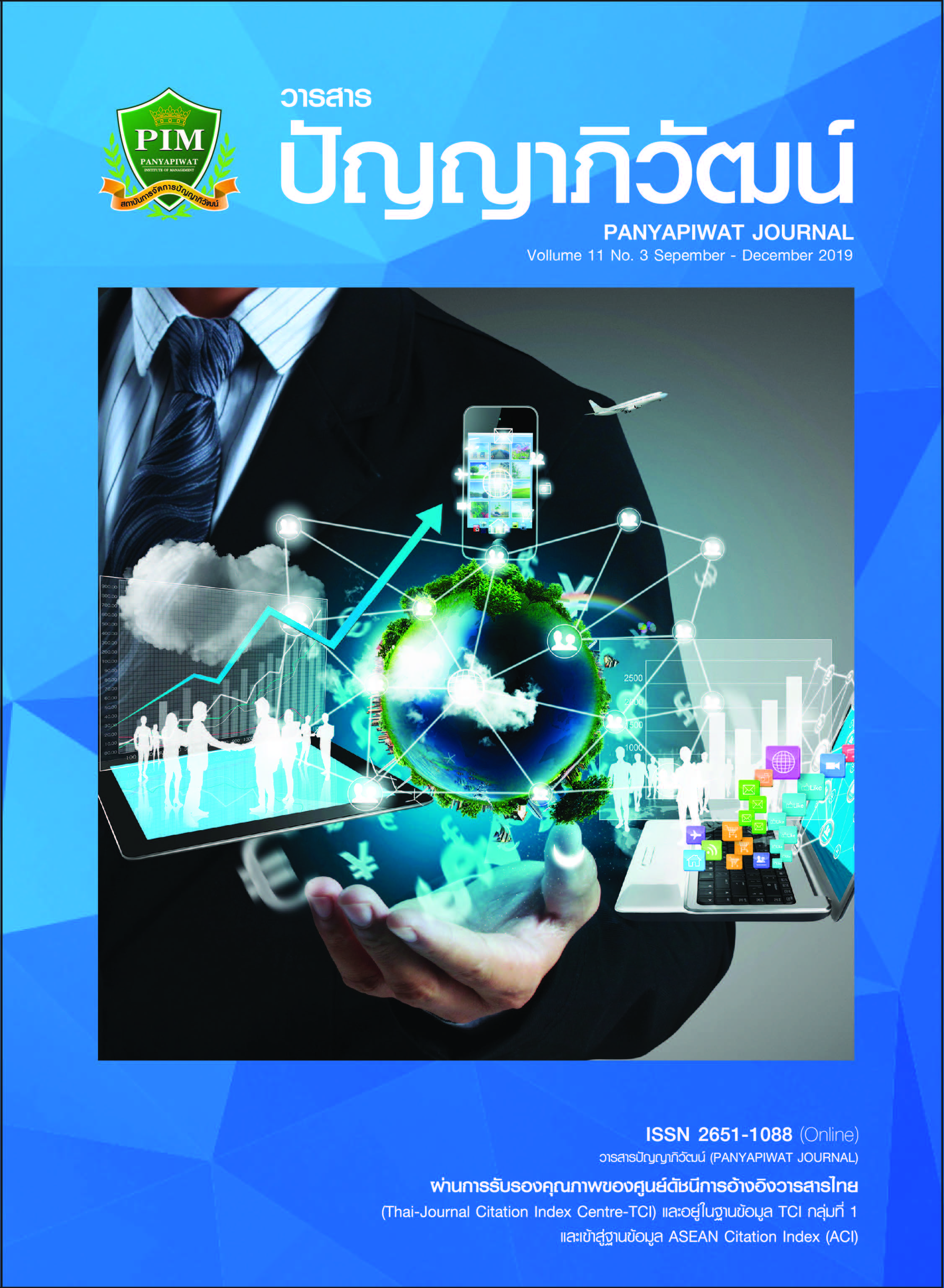THE INFLUENCE OF TRANSFORMATIONAL LEADERSHIP AND TEAM EMOTIONAL ATMOSPHERE ON EMPLOYEES’ INNOVATIVE BEHAVIOR
Main Article Content
บทคัดย่อ
With the globalization of the global economy and the intensification of competition pressure, how to stimulate employee innovation to maintain the sustained growth of corporate profits has become the key. Based on the theories of leadership behavior and emotional events, this study proposes a research model on the relationship between transformational leadership, team emotional atmosphere and employees' innovative behaviors. In Sichuan, Chongqing, Guangxi, Beijing and other places, 114 teams and 700 employees were evaluated. The measurement scale is divided into two versions: the team leader questionnaire and the team member questionnaire.
In this paper, through correlation analysis and partial correlation analysis for data analysis, the results found that: transformational leadership can influence employees' innovative behaviors through team emotional atmosphere mediator variables.
Article Details
“ข้าพเจ้าและผู้เขียนร่วม (ถ้ามี) ขอรับรองว่า บทความที่เสนอมานี้ยังไม่เคยได้รับการตีพิมพ์และไม่ได้อยู่ระหว่างกระบวนการพิจารณาลงตีพิมพ์ในวารสารหรือแหล่งเผยแพร่อื่นใด ข้าพเจ้าและผู้เขียนร่วมยอมรับหลักเกณฑ์การพิจารณาต้นฉบับ ทั้งยินยอมให้กองบรรณาธิการมีสิทธิ์พิจารณาและตรวจแก้ต้นฉบับได้ตามที่เห็นสมควร พร้อมนี้ขอมอบลิขสิทธิ์บทความที่ได้รับการตีพิมพ์ให้แก่สถาบันการจัดการปัญญาภิวัฒน์หากมีการฟ้องร้องเรื่องการละเมิดลิขสิทธิ์เกี่ยวกับภาพ กราฟ ข้อความส่วนใดส่วนหนึ่งและ/หรือข้อคิดเห็นที่ปรากฏในบทความข้าพเจ้าและผู้เขียนร่วมยินยอมรับผิดชอบแต่เพียงฝ่ายเดียว”
เอกสารอ้างอิง
Baron, R. M. & Kenny, D. A. (1986). The moderator-mediator variable distinction in social psychological research: Conceptual, strategic, and statistical considerations. Journal of Personality and Social Psychology, 51, 1173-1182.
Bass, B. M. & Avolio, B .J. (2000). Multifactor leadership questionnaire for research. Mind Garden: Redwood City.
Burns, J. M. (1978). Leadership. New York. NY: Harper & Row.
Ding, L., Xi, Y. M. & Zhang, H. (2010). Transformational leadership and employee innovation: the mediating role of leader-subordinate relationship. Scientific research management, 31(1), 177-184. [in Chinese]
Elfenbein, H. A. & Shirako, A. (2006). An emotion process model for multicultural teams. In B. Mannix, M. Neale & Y. R. Chen (Eds.), Research on managing groups and teams Vol. 9. National culture and groups. UK: Emerald Publishing Limited.
Grawitch, M. J., Munz, D. C. & Kramer, T. J. (2002). Effects of member mood states on creative performance in temporary workgroups. Group ebnamics: Theory. Research and Practice, 7(1), 41-54.
Härtel, C. E. J., Helen, G. & Hartel, G. F. (2012). Work-group emotional Emotion management skills, and service attitudes and performance. Asia Pacific Journal of Human Resources, 46(1), 21-37.
_____. (2012). How emotional climate in teams affects workplace effectiveness in individualistic and collectivistic contexts. Journal of Management and Organization, 18(4), 13.
House, R. J. (1996). Path-goal Theory of Leadership: Lessons, Legacy, and a Reformulated Theory. The Leadership Quarterly, 7(3), 323-352
Lee, Y. & Chang, H. (2006). Leadership style and innovation ability: an empirical study of Taiwanese and cable companies. Journal of American Academy of Business Cambridge, 9(2), 218-222. [in Chinese]
Liang, F. & Li, S. (2016). The Study on the Relationship Between Transformational Leadership and Employee Innovative Behavior: A Cross-layer Model. Science & Technology Progress and Policy. 33(24), 147-153. [in Chinese]
Liu, X. Y. & Liu, J. (2012). The influence mechanism of team emotion atmosphere on team innovation performance. Journal of psychology, 44(4), 546-557. [in Chinese]
Liu, Y. & Shi, J. T. (2009). The research logic of authorization theory-the development of the concept of psychological authorization. Journal of Shanghai Jiaotong university (philosophy and social sciences edition), 18(1), 54-59. [in Chinese]
Liu, X. Y., Sun, J. M. & Hartel, C. E. J. (2008). Developing a Measure of Workgroup Emotional Climate in China International. Journal of Psychology, 43(3/4), 285. [in Chinese]
Shin, S. J. & Zhou, J. (2003). Transformational Leadership, Conservation, and Creativity: Evidence from Korea. Academy of Management Journal, 46(6), 703-714. [in Chinese]
Su, Y., Cui, M. M. & Sun, Y. (2017). The influence of shared transformational leadership on employee s innovation behavior- Regulating effect based on power distance. Science and technology management research, 22(2), 125-132. [in Chinese]
Walter, F. & Bruch, H. (2010). Structural impacts On the Occurrence and Effectiveness of Transformational Leadership: an Empirical Study at the Organizational Level of Analysis, Leadership Quarterly, 5(21), 765-782.
Weiss, H. M. & Cropanzano, R. (1996). Affective Events Theory, a Theoretical Discussion of the Structure, Causes and Consequences of Affective Experiences at Work. Research in Organizational Behavior, 18(8), 1-74.
Wu, W. H. & Zhao, H. B. (2010). Research on the influence of leadership style on innovation behavior of knowledge workers. Scientific & technological progress and Policy, 27(2), 153-156. [in Chinese]
Zhou, Q., Hirst, G. & Shipton, H. (2012). Context Matters: Conypined Influence of Participation and Intellectual Stimulation on The Promotion Focus-employee Creativity Relationship. Journal of Organizational Behavior, 33(7), 894-909. [in Chinese]
Zhu, S. Y., Qi, E. S. & Xu, Y. (2008). An Empirical Study of the relationship among transformational leadership, team climate, knowledge sharing and performance of team innovation. Soft science, 22(11), 1-4. [in Chinese]


